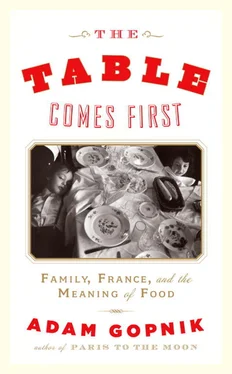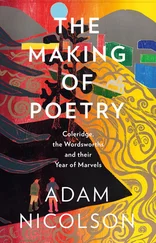What made the food scene spring up in Paris? What made the writers critique food instead of love or life or pure reason? Older histories, as we’ve seen, tend to put the “creative” moment a little too late, and say that chefs were pushed out from the aristocratic houses as the mouths they fed were lost along with the heads around them, and, desperate to make a living, they opened restaurants. But no one, however desperate, starts a business without perceiving an unmet demand; a place to sell food for money would never have opened if the interest wasn’t there to start.
Historians now tend to put their finger on a few linked causes for the new “field.” First, and most important, though easy to forget, was the end of famine in France. We take the fact of plenty now so much for granted that the press of scarcity can strike us as charming, or even, at times, enviable: how they must have enjoyed having strawberries only in season, a steak once a month. And if they missed a season or couldn’t get a steak, all the more relish when they finally had it! In truth, starvation was, through the eighteenth century and well into the nineteenth, a constant fear, a yearly specter in Europe. As Ferguson writes, “Cyclical famines had ravaged the continent for centuries.” New methods of farming; new means of distribution, instanced by the growth of central city markets; and, above all, the end of the feudal order, with its monopolies of grain and other goods, resulted (in most places, at most times, for most people) in, at last, enough to eat throughout Europe. The first need for those who want to reflect on the meaning of lunch is the certainty of having dinner. Though there were periods of hunger through the revolution, they were only periods. There were still famines, during the Terror, but people thought of them as discrete crises because they didn’t happen all the time. Bad and cruel things still happened, but France, at least, was now a country of relative plenty.
Scarcity creates sanctions; abundance encourages altruism. When your plate is empty, you are inclined to see eaters as sinners; when your plate is full, gluttony looks fine. In a Catholic country like France, the new plenty helped promote a more relaxed idea of pleasure. The second change, linked to the end of famine, was that enjoying food for its own sake came to be regarded not as an instance of gluttony but a virtue of its own. So the sudden release from the bonds of guilt creates an exhalation of pleasure. “Luxury” suddenly looks like life. Voltaire wrote a poem about this change called “The Man of the World,” in which he tries to show that everything once called superfluous can be seen as truly needed. Once we accept more than subsistence living, which needs are on the money, which over the top? The pace of freedom quickened, so that by the time that Eugène Sue’s novel The Seven Deadly Sins appeared, in 1848, he could argue that the “sins” are not deadly at all, that they are in truth blessings—and gourmandise one of the best among them. All the people in Sue’s imaginary family are in the food business—butcher, baker, fishmonger, food importer—and they all come together in the end to celebrate the good things that come from a life devoted to what would have once been called gluttony. From seeing the table as the enemy of virtue to pressing the glutton button at will—few alterations in human consciousness have been larger, or taken place over less time. It was a world changing its mind, as much as cooks changing places, that made Paris the capital of food, and caused the invention of the thing that we call French cooking.
There was still another distinction in the Parisian instance, this one built into the fact of food. Citing classical models had long been the best way to affirm the importance of a new thing. But everyone could sense that the way that Romans and Greeks ate, at least as recorded in their literature, was no way anyone wanted to eat now. The food of the ancient Romans—swans stuffed with live larks, and then refunded in a vomitorium—already seemed too odd to imitate.
While Carême looks back to classical architectural models for his grand pièces montées , his ideas about the food itself are empirical, practical, and inductive—thought from the bottom up rather than imposed from a noble past. His cookbook begins with the pot-au-feu—the simple braised beef that is still one of the best good things in the French kitchen—which he recognizes as the source of stocks, and he treats it to a chemical analysis. What remained of “Roman” spices—that heady, intoxicating play of ginger and pepper and cinnamon—was banished, too, and replaced by “no high spiced sauces, no dark brown gravies… every meat presented its own natural aroma, every vegetable its own shade of verdure.” Whatever eating was to be, we were going to have to make it up. The scene was probably more open for innovation in cooking than in almost any other field. There are times in the history of culture when the “minor” arts lead the major; the Dutch designer Rietveld’s chairs were “abstract” studies in primary colors before Mondrian learned from him and made it art. Cooking was the first of the modern arts to do entirely without classical sanction and the first to claim it modeled itself on nature alone—and, to a reasonable degree, it actually did so. At Carême’s table you could eat chicken with chervil even before, at Corot’s easel, you could see Italy as it was.
* * *
Morals change, then meals; desires drive our diets. Of all the new jobs that the new scene made, the most potent was that of the chronicler of changing desires, the pro food writer—the “gastronomic journalist.” The emergence of journalists, with their natural affinity for eating, was one of the events of the day. Journalists, Grimod de La Reynière tells us, are all big eaters and drinkers: “recognizable by their apoplectic throats, their bushy mustaches, and their puffy bibulous visages.”
It was Brillat-Savarin, the wandering French food lover and exile of the mixed-up Napoleonic and post-Napoleonic period, long resident in the newborn United States, who wrote the first great book about taste and why it matters, that famous 1825 Physiology of Taste . Brillat-Savarin’s book was, or seemed to be, one of the first rule books, the first attempts to put “gastronomy”—the word he made famous—on a semiscientific basis: to make the serious study of cooking and eating one more of the Enlightenment’s subjects, to be pinned in an encyclopedia. Yet though his tone was mock-scientific, his purpose was humane—he was an expatriate essayist, poor guy—and his theme was simple. For Brillat-Savarin, gastronomy is the great adventure of desire. Its subject is simple: the table is the place where a need becomes a want. Something we have to do—eat—becomes something we care to do—dine—and then something we care to do becomes something we try to do with grace. Eating together is the civilizing act. We take urges, and tame them into tastes.
Brillat-Savarin wasn’t really writing an encyclopedia of sensations; he was writing a book on the reach of pleasures. We chew with our molars, but eat with our minds. “The pleasure of the table is a reflected sensation, originating in various facts, places, things and persons [taking in] all the modifications of society which extreme sociability has introduced among us: love, friendship, business, speculation, power, ambition, and intrigue, all enhance conviviality.” His allied subject was sex, which also began with a gasp and was tamed into a game. “I observe with pride, that gourmandise and coquettery, the two great modifications which society has effected in our imperious wants, are both of French origin,” he wrote. Flirtation, like good cooking, was the way impulse submitted to social discipline—manners.
Читать дальше












